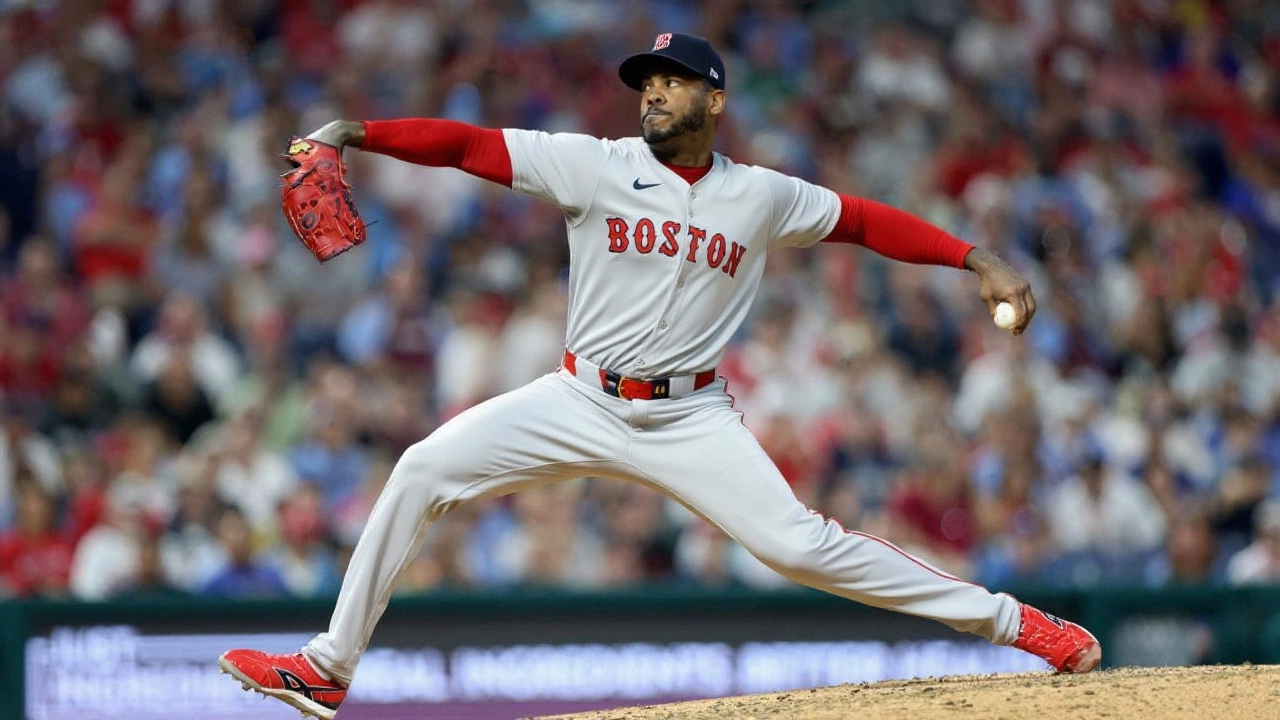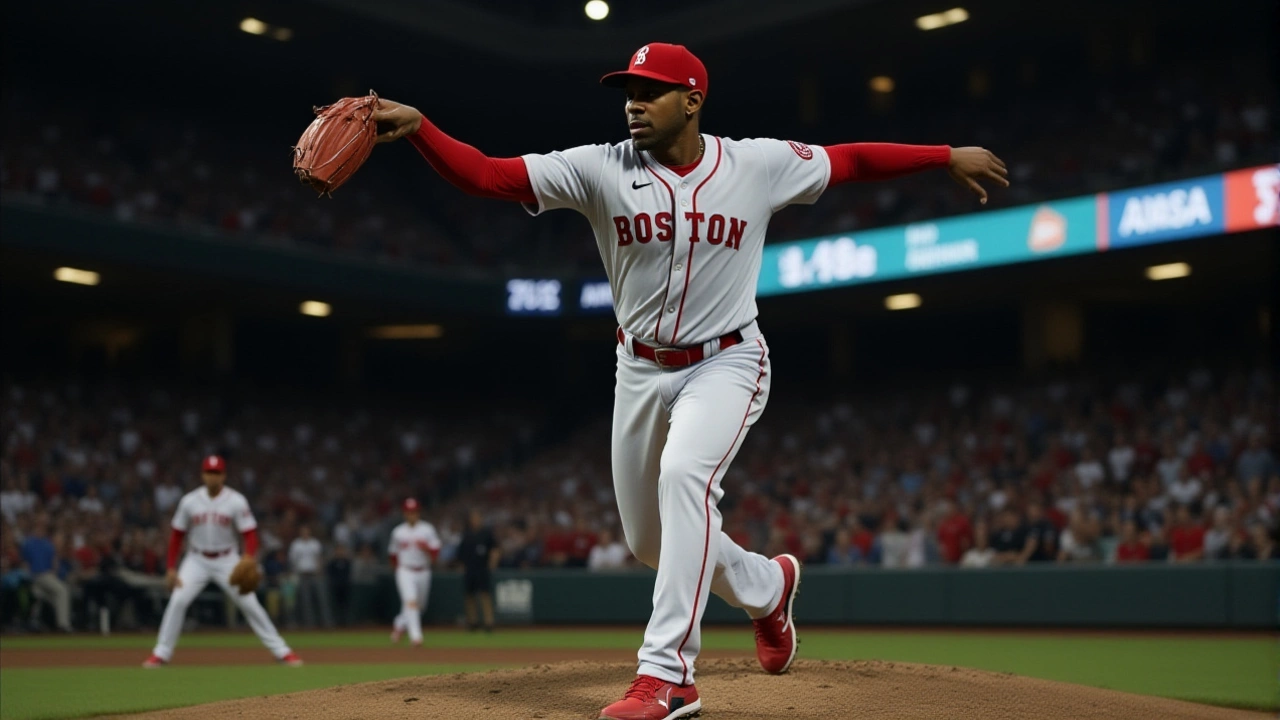When Aroldis Chapman, the 37‑year‑old left‑handed closer for the Boston Red Sox agreed to a multi‑year extension on Sunday, the deal signals Boston’s commitment to a veteran arm as it chases a postseason berth. The agreement was reached on September 8, 2025, in Boston, and will keep Chapman on the roster through the 2026 season with a vesting option for 2027. Negotiated by chief baseball officer Craig Breslow, the contract guarantees $13.3 million while attaching performance triggers that protect the club if the 37‑year‑old’s health declines.
Background and the 2026 Contract Details
Chapman arrived in Boston on a one‑year, $10 million deal signed in December 2024. What looked like a low‑risk lottery ticket quickly turned into a cornerstone of the bullpen. The new agreement adds a $1 million signing bonus payable by January 15, 2026, and a $12 million base salary for the 2026 season. A mutual option for 2027 carries a $13 million price tag, but the Red Sox can buy it out for $300,000 if they choose to walk away. The option automatically vests if Chapman pitches at least 40 innings in 2026 and passes a post‑season physical, a clause designed to reward durability.
Beyond the base figures, the contract includes escalators tied to potential awards – such as the AL Reliever of the Year – though the exact bonus amounts remain undisclosed. In total, the structure blends guaranteed compensation with safeguards, a balancing act that reflects both Chapman’s elite pedigree and the risk inherent in extending a 37‑year‑old pitcher.
Chapman's 2024‑25 Season: Numbers That Speak
Statistically, Chapman is having a career resurgence. In 54 innings pitched, he posted a career‑low 1.00 ERA and fanned 77 batters – a strike‑out rate of 12.8 K/9. He converted 28 of 30 save opportunities, translating to a 93.3% conversion rate. Alternative box scores from the team’s internal trackers listed 26 saves in 52 innings over 57 appearances, but the consensus remains clear: the veteran is dominant.
His 361 career saves now rank 13th on the all‑time list, a milestone that few relievers achieve before turning 38. The consistency has been remarkable – his velocity still touches the high 90s, and his slider shows the same late‑break that made him a star in Atlanta and New York. For a closer who has spent a decade in the majors, maintaining sub‑2.00 ERA levels at this stage is almost unheard of.
Strategic Rationale from the Front Office
"We wanted to keep a proven closer who can still dominate late‑innings situations," Breslow said in a post‑game interview on September 9. "Aroldis brings not just the stuff, but the poise that helps the younger guys understand what it takes to finish games." The statement underscores a broader strategy: Boston is blending veteran stability with a pipeline of high‑upside arms like rookie right‑hander Luis Rojas.
Analysts note that the extension also sends a signal to free‑agent markets – the Red Sox are willing to spend money on proven talent rather than gamble on untested prospects. Former MLB scout and ESPN analyst Keith Law observed, "In an era where teams are shying away from big contracts for aging relievers, Boston’s move is a calculated gamble that could pay dividends if Chapman stays healthy through 2027."

Financial Structure and Incentives
- Signing bonus: $1 million due Jan 15 2026
- 2026 base salary: $12 million
- 2027 mutual option: $13 million (buy‑out $300 k)
- Vesting clause: 40+ innings in 2026 + clean physical
- Performance escalators tied to AL Reliever of the Year and Save Leader awards
By front‑loading the deal with a modest bonus and a sizable base, the Red Sox limit their exposure if Chapman’s performance dips. The vesting mechanism, meanwhile, aligns incentives – the club only commits the full $13 million for 2027 if Chapman proves he can still shoulder a heavy workload.
Implications for Boston’s Bullpen and the AL East Race
With the extension locked in, the Red Sox can plan the next two seasons without worrying about a mid‑season closer scramble. The bullpen, already anchored by left‑hander Matt Barnes and rising right‑hander Jake McCarthy, now has a clear hierarchy: Chapman as the 9th‑inning authority, Barnes handling high‑leverage 7th‑8th innings, and McCarthy ready to step into the setup role.
For the AL East, Boston’s move adds stability to a division where rivals like the New York Yankees and Tampa Bay Rays have been experimenting with opener‑style rotations. A reliable closer can be the difference in tight series, especially when the Red Sox face the Yankees in September – a matchup that often decides the division crown.
Looking ahead, if Chapman stays on the mound for the required 40 innings, the 2027 option becomes guaranteed, effectively giving Boston a 13‑year veteran presence in the bullpen (when you count his prior stints). Even if the option is bought out, the club retains flexibility to explore younger talent without a massive financial burden.
What Comes Next?
The Red Sox are expected to file the official contract paperwork with MLB by the end of the week. Until then, the front office will likely focus on reinforcing the middle relief corps at the trade deadline, knowing that the back end of the bullpen is now secure. Fans can anticipate an October with Chapman potentially chasing his fourth Reliever of the Year award – a storyline that would add drama to the postseason race.

Frequently Asked Questions
How does the extension affect the Red Sox’s payroll?
The deal adds $13.3 million in guaranteed money over the next two seasons, but the structure – a $1 million bonus, a $12 million base, and a conditional $13 million option – limits long‑term risk. If Chapman fails the 2026 innings threshold, the club can buy out the 2027 option for $300 k, keeping overall payroll flexible.
What performance criteria must Chapman meet for the 2027 option to vest?
He must pitch at least 40 innings during the 2026 season and pass a post‑season physical that confirms he is fit for the opening day roster in 2027. Meeting both conditions automatically converts the option into a guaranteed $13 million salary.
Why did the Red Sox choose to lock up an aging closer instead of pursuing a younger arm?
Chief Baseball Officer Craig Breslow said the club values proven late‑inning performance as it fights for a postseason spot. Chapman’s elite velocity and recent 1.00 ERA provide immediate impact, while the contract’s conditional 2027 clause protects the team if his durability declines.
How does Chapman’s career save total rank historically?
With 361 career saves, Chapman sits 13th on the all‑time saves leaderboard, behind legends like Mariano Rivera and Trevor Hoffman. Reaching that mark at age 37 underscores his longevity and places him among the elite closers in MLB history.
What impact could this contract have on the AL East race?
A reliable closer stabilizes late‑game situations, which can turn tight games into wins. As the Red Sox battle the Yankees and Rays for the division crown, Chapman’s ability to shut down opponents in the ninth inning could be the deciding factor in September series.
